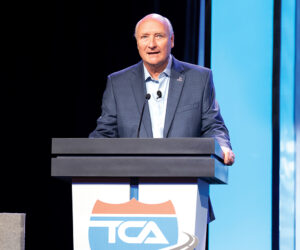As this issue of Truckload Authority hits the wire, John Elliott is racing hard toward the finish line of a highly motivating and extremely successful tenure as chairman of the Truckload Carriers Association (TCA). It seems only yesterday he stepped up to the starting line to accept the gavel from outgoing chairman Jim Ward, who is now TCA president. Whether it’s the 100-meter dash or the 5,000-meter run, it takes skill and a well-thought-out strategy to win a race. For the 100-meter run, it’s a mad dash from start to finish. For the 5,000-meter race, it’s all about pacing — being aware of other runners, having an understanding of how many meters there are to the finish, and knowing how much stamina you have left. John Elliott has exhibited the skill to handle any length of race. He’s used his leadership skills to react to suddenly arising issues, such as the surge in diesel prices, as well as long-term problems, such as the driver shortage and lack of truck parking. In this edition, he addresses those three issues along with others. He outlines all-new plans for TCA’s annual convention coming up in March, and reviews the success of the Bridging Border Barriers meeting in November.
Question: Mr. Chairman, thank you for joining us for another Chat with the Chairman. We hope you had a merry Christmas and a happy new year. As one year ends and another begins, it is time to reflect on the year just ended. First, share with us the top achievements of the trucking industry in 2022.
Answer: Thank you. I hope everyone had a happy holiday season! The year 2022 was really a year of success for our industry on many levels. Some of the biggest include the entry-level driver training requirements, the younger-driver apprenticeship program, some streamlining of the Drug and Alcohol Clearinghouse, removal of redundancy on the TWIC and HAZMAT background checks, getting a Federal Motor Carrier Safety Administration (FMCSA) leader who was officially appointed by Congress, and the victory against Rhode Island on its discriminatory tolling.
Question: Second, what were TCA’s major achievements?
Answer: Well, many of the things I have already spoken of were supported and were helped across the finish line with the support of TCA. Internally the organization is really firing on all cylinders. We continue to have record membership numbers. All our events this past year have seen resounding feedback and record attendance. Our officers, leadership, and staff have really rolled up their sleeves when it comes to delivering value to the membership.
Question: What challenges does 2023 hold, both for the trucking industry as a whole and for TCA?
Answer: As for the industry, I think we have a lot of hard work and battles ahead. California’s AB5 and the continued attack on the owner-operator model is an issue of great concern for me. So many of the companies in our industry started with one person and one truck! Trucking is one of the best examples of the American dream and the spirit of entrepreneurship. Yet some in political office look to burden this great path to business success. I think one of the other looming issues is environmental mandates that sound great on paper but do not have a practical path to success at this time and in the time frames proposed. Our industry continues to push to get greener, but we have to do it at a logical, sustainable pace that makes some sense economically — and we have to have an infrastructure capable of supporting that effort.
Question: As you enter the home stretch of your term as chairman, what does your schedule look like for January and February?
Answer: Luckily, this is a slower time of the year coming off the holidays. I have some industry events to attend and to represent TCA. I will also be making some trips to the TCA headquarters for leadership transition planning and to participate with our refrigerated officers in the planning of the annual refrigerated meeting. Somehow when I say not as busy, my calendar finds a way to fill up fast!
Question: Obviously, the highlight of the last month of your chairmanship — March — will be TCA’s annual convention, set for March 4-7 at the Gaylord Palms in Kissimmee, Florida. We have heard that TCA will roll out a new convention format this year. Share with us what members can expect at the 2023 convention and why it is important to attend the event.
Answer: CA’s annual convention is the flagship program for the association. As a member-driven organization, it only makes sense that we rely upon our members to develop the content and offerings industry executives want to know about. We appointed Karen Smerchek, president of Veriha Trucking, to work with a task force of carriers and associate members to develop the schedule, sessions, and speakers that should make every potential attendee take notice. In other words, this meeting has been designed for our members, by our members — and I can guarantee you will be bringing something back to the office that will justify your attendance.
Question: Each year, the American Transportation Research Institute (ATRI) releases the results of its “Critical Issues in the Trucking Industry” survey of motor carrier executives and drivers. For 2022, a year of record inflation, it’s not surprising that fuel prices topped the list as the No. 1 overall concern. This is the first time the topic of has appeared since 2014. What do you hear from members — both carriers and independent contractors — about how the cost of diesel is impacting their business? Are they seeing any easing of those high prices?
Answer: At the time of this interview, we are not seeing any easing. While gas prices have fallen, diesel prices have not. It is a common “feedstock” with heating oil and the cold winter that has driven up demand. Refining capacity also continues to be a serious constraint. While the general public feels economic relief with lower gas prices, the cost of diesel really helps drive consumer cost and inflation, as that cost ultimately gets passed along to the end user —the consumer.
Question: The driver shortage ranked second among the overall concerns. Is there any indication the shortage may be easing? Or, at least, are there new programs or new policies in place that promise pathways to ease the shortage?
Answer: The driver shortage and stress it has had on the supply chain is no secret. Looking at the recent actions that have come from FMCSA and the Department of Transportation (DOT) in the past year, this problem has certainly reached a crisis level in the office of the Secretary of Transportation. In addition to the entry level driver training rule that went live last February, our industry is embroiled in other programs that focus on recruiting people to become interested in the truck-driving profession. The younger driver pilot program that is determining once and for all that drivers ages 18 to 20 can operate in a manner as safe (or safer) than their more seasoned counterparts could open our industry up to a demographic to operate in interstate commerce that we had not been exposed to before. The creation of federally recognized apprenticeship programs that will encourage people to get into our industry is yet another prime example. The Women of Trucking Advisory Board, through FMCSA, is exploring ways to make trucking a more attractive option for females to enter our industry. Considering that women make up approximately 7% percent of the driving workforce, there is certainly room for improvement.
Question: No. 8 on the overall list of concerns was CSA. For years, it was a hotly debated issue in trucking, but recently it seems like CSA disappeared from the radar. Has CSA been effective in improving safety in the trucking industry? Does the program need an overhaul?
Answer: That is a great question. Keep in mind the promise that was made when this program made its first appearance under the name CSA2010 — that replacing Safestat would be a great thing and that eventually drivers would be incorporated into that premise. We have certainly come a long way from that originally proposed date. I think CSA has certainly influenced how carriers operate and the safety programs that coincide with it; however, there is so much more that needs to be done. First and foremost, any overhaul that coincides with CSA must come with the ability to actually explain it, which the proposed Item Response Theory (IRT) certainly lacks. Carriers are not against having their safety fitness determined; we must, however, insist that it is determined correctly. The shortcoming with CSA must be taken into account when contemplating these changes so that a level playing field exists for the industry in its entirety.
Question: The ATRI survey breaks down its results by commercial drivers and motor carrier executives. Among drivers, the top concern continues to be truck parking. Can you update members on the progress of programs in place to address this issue?
Answer: I think everyone would agree, including members of the House and Senate, that there is a definite need to fix this problem. Not only would it help our driving force to operate in a manner that makes their profession a more attractive place to work, but it would also help our nation’s supply chain shortage by alleviating the constant search for a safe, secure place to park a truck. As an industry, we must advocate for dedicating funding to help resolve this issue. TCA was successful in getting language that highlighted this problem into the recent House Appropriations bill, a win for TCA and its efforts to fix this problem. However, this is not just an issue that exists for federal intervention. Efforts within each state, county, and municipality must continue, and we have found educating local governments will go a long way towards improving upon this problem and combatting the misinformation that seems to exist at the local level when it comes to creating new avenues for truck parking.
Question: Each year, the Commercial Vehicle Safety Alliance conducts safety checks on the nation’s highways. In 2022, out of some 34,000 trucks inspected in the U.S. during Brake Safety Week, 4,664 (13.6%) were put out of service for various brake violations. Does it concern you, as an industry leader, that more than one out of every 10 CMVs on the highway today might be operating with serious brake problems?
Answer: Hauling freight in this industry is certainly dependent upon the ability to deliver a load safely. Yes, the number of vehicles placed out of service for brake violations is concerning, since the impact of those poorly maintained brakes can have life-or-death consequences. Obviously, the reason these vehicles have been placed out of service is because of the unsafe nature in which they can be operating. Unfortunately, nine out of every 10 CMVs suffer from the negative aspects of proper maintenance that can often be discovered with a thorough pre-trip inspection rather than a roll of the dice.
Question: TCA participated in three important events during November and December — the Sixth Annual Bridging Border Barriers conference, held in Canada; the transport of the U.S. Capitol Christmas Tree and its lighting ceremony in Washington, D.C.; and Wreaths Across America. Please share the highlights of these events and why it’s important for TCA to participate in these events.
Answer: Bridging Border Barriers was a great success in 2022. We saw the largest attendance since the inception of the conference. The content covered a diverse set of subject matter that educated our Canadian and cross-border carrier members. Many do not realize that over 10% of TCA membership is Canadian. On top of that, a good percentage of our American members offer cross-border service in and out of Canada.
The Capital Christmas Tree and Wreaths Across America are both great programs that allow the trucking industry to join with these causes and showcase to the public the importance and the generosity and level of caring that the trucking industry showcases.
Question: Two November events highlighted the role of women in trucking. First, the FMCSA held the inaugural meeting of the Women of Trucking Advisory Board. Later in the month, the Women In Trucking Association held its annual Accelerate! Conference and Exhibition. Both are designed to bring more women into the industry, which prompts the question: Is the industry doing enough in addressing this important matter?
Answer: I think it’s hard to say whether we are doing enough. I do think that as an industry we are doing more than at any time in trucking’s history. I think the industry is engaged, and a lot of great people are helping to lead this charge. I think the best plan is to keep addressing and tackling the issue and to continue to find ways to step up and improve constantly.
This article originally appeared in the January/February 2023 edition of Truckload Authority, the official publication of the Truckload Carriers Association.
Lyndon Finney’s publishing career spans over 55 years beginning with a reporter position with the Southwest Times Record in Fort Smith, Arkansas, in 1965. Since then he’s been a newspaper editor at the Southwest Times Record, served five years as assistant managing editor of the Arkansas Democrat-Gazette in Little Rock and from November 2004 through December 2019 served as editor of The Trucker. Between newspaper jobs he spent 14 years as director of communications at Baptist Health, Arkansas’ largest healthcare system. In addition to his publishing career he served for 46 years as organist at Little Rock’s largest Baptist church.















